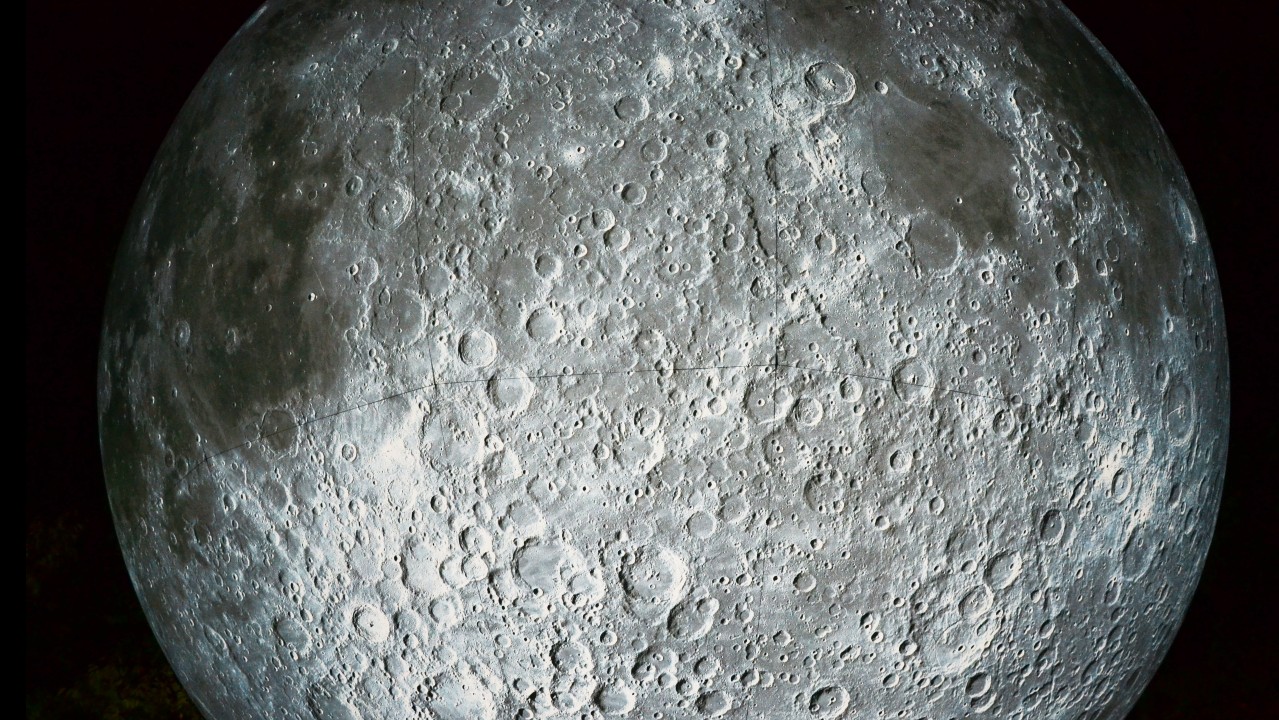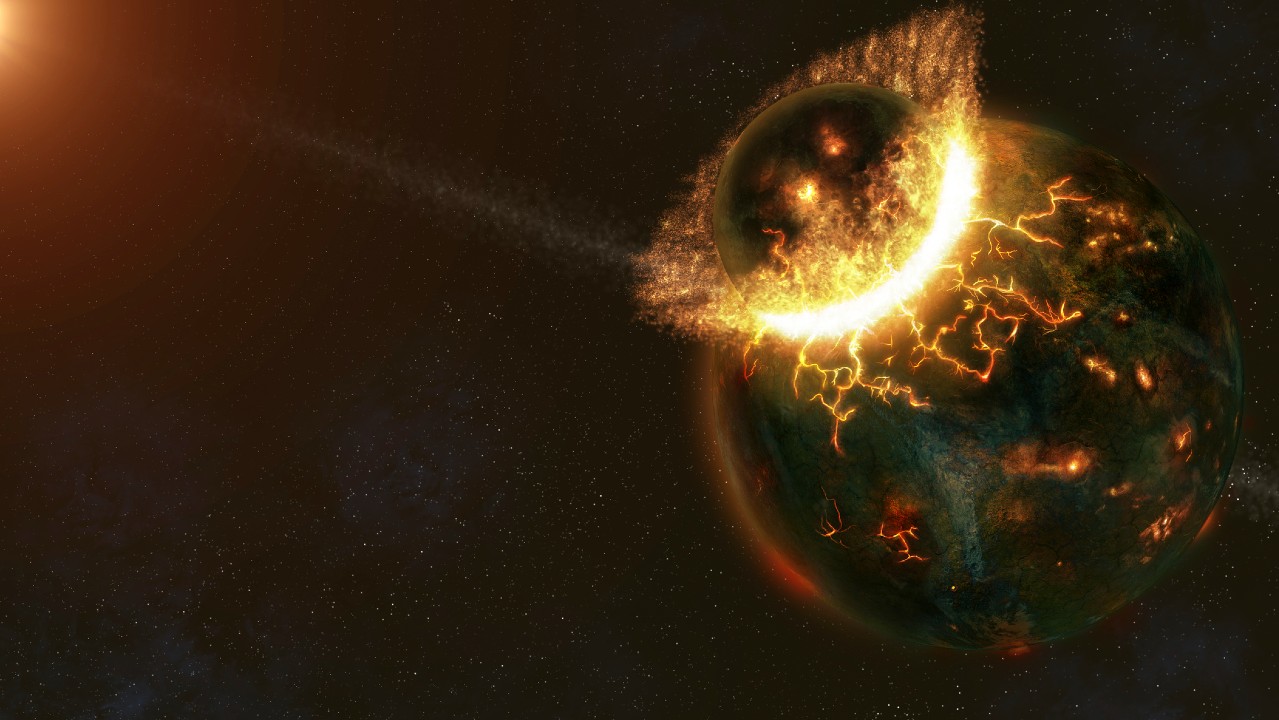How was the moon formed?
Scientists are still unsure as to how the moon formed, but here are three of their best bets.

The moon formed a hundred million years after the creation of the solar system. This has left scientists wondering what was the cause of our planet's satellite to birth if it didn't come from the events that formation of the planets. Here are just three of the most plausible explanations.
Giant impact hypothesis
The prevailing theory supported by the scientific community, the giant impact hypothesis suggests that the moon formed when an object smashed into early Earth. Like the other planets, Earth formed from the leftover cloud of dust and gas orbiting the young sun. The early solar system was a violent place, and a number of bodies were created that never made it to full planetary status. One of these could have crashed into Earth not long after the young planet was created.
Known as Theia, the Mars-sized body collided with Earth, throwing vaporized chunks of the young planet's crust into space. Gravity bound the ejected particles together, creating a moon that is the largest in the solar system in relation to its host planet. This sort of formation would explain why the moon is made up predominantly of lighter elements, making it less dense than Earth — the material that formed it came from the crust, while leaving the planet's rocky core untouched. As the material drew together around what was left of Theia's core, it would have centered near Earth's ecliptic plane, the path the sun travels through the sky, which is where the moon orbits today.

According to NASA, "When the young Earth and this rogue body collided, the energy involved was 100 million times larger than the much later event believed to have wiped out the dinosaurs."
Although this is the most popular theory, it is not without its challenges. Most models suggest that more than 60%of the moon should be made up of the material from Theia. But rock samples from the Apollo missions suggest otherwise.
"In terms of composition, the Earth and moon are almost twins, their compositions differing by at most few parts in a million," Alessandra Mastrobuono-Battisti, an astrophysicist at the Israel Institute of Technology in Haifa, told Space.com. "This contradiction has cast a long shadow on the giant-impact model."
In 2020 research published in Nature Geoscience, offered an explanation as to why the moon and Earth have such similar composition. Having studied the isotopes of oxygen in the moon rocks brought to Earth from Apollo astronauts, researchers discovered that there is a small difference when compared with Earth rocks. The samples collected from the deep lunar mantle (the layer below the crust) were much heavier than those found on Earth and "have isotopic compositions that are most representative of the proto-lunar impactor ‘Theia’", the study authors wrote.
Breaking space news, the latest updates on rocket launches, skywatching events and more!
Back in 2017, Israeli researchers proposed an alternative impact theory which suggests that a rain of small debris fell on Earth to create the moon.
"The multiple-impact scenario is a more natural way of explaining the formation of the moon," Raluca Rufu, a researcher at the Weizmann Institute of Science in Israel and lead author of the study, told Space.com. "In the early stages of the solar system, impacts were very abundant; therefore, it is more natural that several common impactors formed the moon, rather than one special one.
Co-formation theory
Moons can also form at the same time as their parent planet. Under such an explanation, gravity would have caused material in the early solar system to draw together at the same time as gravity bound particles together to form Earth. Such a moon would have a very similar composition to the planet, and would explain the moon's present location. However, although Earth and the moon share much of the same material, the moon is much less dense than our planet, which would likely not be the case if both started with the same heavy elements at their core.
In 2012, researcher Robin Canup, of the Southwest Research Institute in Texas, proposed that Earth and the moon formed at the same time when two massive objects five times the size of Mars crashed into each other.
"After colliding, the two similar-sized bodies then re-collided, forming an early Earth surrounded by a disk of material that combined to form the moon," NASA said. "The re-collision and subsequent merger left the two bodies with the similar chemical compositions seen today.
Capture theory
Perhaps Earth's gravity snagged a passing body, as happened with other moons in the solar system, such as the Martian moons of Phobos and Deimos. Under the capture theory, a rocky body formed elsewhere in the solar system could have been drawn into orbit around Earth. The capture theory would explain the differences in the composition of Earth and its moon. However, such orbiters are often oddly shaped, rather than being spherical bodies like the moon. Their paths don't tend to line up with the ecliptic of their parent planet, also unlike the moon.
Although the co-formation theory and the capture theory both explain some elements of the existence of the moon, they leave many questions unanswered. At present, the giant impact hypothesis seems to cover many of these questions, making it the best model to fit the scientific evidence for how the moon was created.
Additional resources
For more on the giant-impact hypothesis, read "The Big Splat, or How Our Moon Came to be: A Violent Natural History"," by Dana Mackenzie. To learn more about the solar system, check out "Our Solar System: An Exploration of Planets, Moons, Asteroids, and Other Mysteries of Space" by Lisa Reichley.
Bibliography
Erick J. Cano et al, "Distinct oxygen isotope compositions of the Earth and Moon", Nature Geoscience, Volume 13, March 2020, https://doi.org/10.1038/s41561-020-0550-0
Raluca Rufu, "A multiple-impact origin for the Moon", Nature Geoscience, Volume 10, January 2017, https://doi.org/10.1038/ngeo2866
Edward Belbruno et al, "Where Did the Moon Come From?", The Astronomical Journal, Volume 129, March 2005.
Thomas S. Kruijer and Gregory Archer, "No 182W evidence for early Moon formation", Nature Geoscience, Volume 14, October 2021, https://doi.org/10.1038/s41561-021-00820-2

Nola Taylor Tillman is a contributing writer for Space.com. She loves all things space and astronomy-related, and always wants to learn more. She has a Bachelor's degree in English and Astrophysics from Agnes Scott College and served as an intern at Sky & Telescope magazine. She loves to speak to groups on astronomy-related subjects. She lives with her husband in Atlanta, Georgia. Follow her on Bluesky at @astrowriter.social.bluesky
